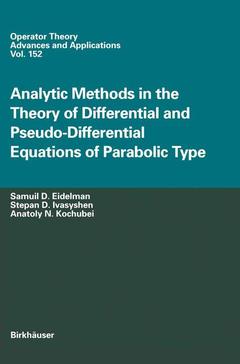Description
Analytic Methods In The Theory Of Differential And Pseudo-Differential Equations Of Parabolic Type, Softcover reprint of the original 1st ed. 2004
Operator Theory: Advances and Applications Series, Vol. 152
Language: English
Analytic Methods In The Theory Of Differential And Pseudo-Differential Equations Of Parabolic Type
390 p. · 15.5x23.5 cm · Paperback
390 p. · 15.5x23.5 cm · Paperback
Analytic methods in the theory of differential and pseudo-differential equations of parabolic type operator theory: advances and applications vol
390 p. · 15.5x23.5 cm · Hardback
390 p. · 15.5x23.5 cm · Hardback
Description
/li>Contents
/li>Comment
/li>
The theory of parabolic equations, a well-developed part of the contemporary partial differential equations and mathematical physics, is the subject theory of of an immense research activity. A continuing interest in parabolic equations is caused both by the depth and complexity of mathematical problems emerging here, and by its importance in specific applied problems of natural science, technology, and economics. This book aims at a consistent and, as far as possible, a complete exposition of analytic methods of constructing, investigating, and using fundamental solutions of the Cauchy problem for the following four classes of linear parabolic equations with coefficients depending on all variables: -7 E : 2b-parabolic partial differential equations (parabolic equations of a qua- l homogeneous structure), in which every spatial variable may have its own to the time variable. weight with respect E : degenerate partial differential equations of Kolmogorov's structure, which 2 generalize classical Kolmogorov equations of diffusion with inertia. E3: pseudo-differential equations with non-smooth quasi-homogeneous symbols. E : fractional diffusion equations. 4 These classes of equations generalize in various directions the classical equations and systems parabolic in the Petrovsky sense, which were defined in [180] and studied in a number of monographs [83, 45, 146, 107, 76] and survey articles [102, 1, 215, 70, 46].
1 Equations. Problems. Results. Methods. Examples.- 1.1 Differential equations.- 1.2 Pseudo-differential equations.- 1.3 Main lemmas.- 2 Parabolic Equations of a Quasi-Homogeneous Structure.- 2.1 Fundamental solution of the Cauchy problem for equations with bounded coefficients.- 2.2 Cauchy problem for equations with bounded coefficients.- 2.3 Equations with growing coefficients.- 2.4 Equations with degenerations on the initial hyperplane.- 2.5 Comments.- 3 Degenerate Equations of the Kolmogorov Type.- 3.1 Fundamental solution of the Cauchy problem.- 3.2 Cauchy problem.- 3.3 Properties of solutions of the Fokker-Planck-Kolmogorov equations.- 3.4 Comments.- 4 Pseudo-Differential Parabolic Equations with Quasi-Homogeneous Symbols.- 4.1 Fundamental solution of the Cauchy problem.- 4.2 Cauchy problem.- 4.3 On qualitative properties of solutions of some equations with constant symbols.- 4.4 Comments.- 5 Fractional Diffusion Equations.- 5.1 Fractional derivatives.- 5.2 Fundamental solution of the Cauchy problem.- 5.3 The Cauchy problem: Existence and representation of solutions.- 5.4 Uniqueness theorems.- 5.5 Comments.- Appendix. Fox’s H-Functions.- Notation.
First book devoted to new classes of parabolic differential and pseudo-differential equations extensively studied in the last decades, such as parabolic systems of a quasi-homogeneous structure, degenerate equations of the Kolmogorov type, pseudo-differential parabolic equations, and fractional diffusion equations Many of these equations are important both for other branches of mathematics, and for applications in physics
© 2024 LAVOISIER S.A.S.




